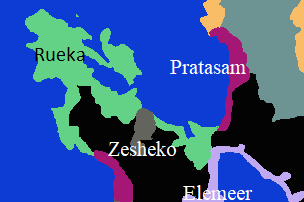Rueka
Rueka is a religion of ritual and process, which imagines the world as a series of roles that they strive to fulfill. Goodness is health is cleanliness is politeness is duty: this is the core thought process that underpins Ruekan faith and culture. This is what separates it from Pratasam, the faith that Rueka theoretically is part of.
Rueka is known as a cold faith by outsiders, a religion that encourages politeness but discourages closeness. It is also a faith of medicine, as even the non-spellcasting priests are dedicated healers.
Structure
The hierarchy of Rueka is fairly simple and direct. Most of the religious structure is managed by the lower-level priests, and the leadership is fairly small and regional. Archdruids are elected by the regional leaders (Kuhanes) every time the secular monarch changes.
Alkoa Priests and Standing Priests sit at the same rank, and are the same in their basic responsibilities of temple management. The only difference is that Alkoa priests are divine spellcasters (typically druids), while Standing Priests are not. Multiple priests can co-exist in the same temple, and many choose to have one of each kind of priest. Alkoa priests are preferred for promotion, but the hierarchy is not exclusive.
While some, particularly in the Temple of Pratasam, argue that Rueka is a sub-group of Pratasam and subject to their Archdruid's directions, the Ruekan Kuhanes generally ignore commands from Samvara. Whether this makes Rueka its own faith or simply a regional variant with its own structure is a matter of debate that is extremely important to people in power, useless to the average community, and constantly left unresolved.
| Title | Role | Selected by |
|---|---|---|
| Archdruid | State-level church administration | The Kuhanes of the realm every coronation |
| Kuhane | Regional church management | The Archdruid or election |
| Priest/Alkoa | Basic church administration | Kuhane/local election |
Culture
Ritual Life
Species, Fashion, and Authority
Cleanliness and Purification
History
Pre-Ruekan Religion
Formation of Rueka (1100 to 1315)
Modern Rueka
Mythology & Lore
The Creation
Lily's Ascent and the Lunar Order
Cosmological Views
The cosmology of Rueka is near-identical to that of Pratasam, with the addition of Vile Rokala, goddess of suffering. Rokala is not a rival to the Gods, but exists as a source for worldly evil that ill-ritual and ill-behavior attracts into the world.
The Lunar Pantheon is deeply revered in Rueka. Lily of Red is seen as the greatest of them and first, but does not rule unilaterally. The Lunar Gods are split into several general tiers: Highest Gods, Good Gods, and Lower Gods. All are valued, but the higher tiers are seen as more relevant and valuable.
Highest Gods: Lily of Red, Jade Atharzen, and Hiku
Good Gods: Wimbo Aizitu, Emesh, Haru, Orchid of Blue
Lower Gods: Agamine the Lost, Theia the Liberator, and Ishkibal
Tenets of Faith
- Follow Tradition: Traditions are a way to commune with the past and keep the sacred law alive. Honor the past and secure your future through them.
- Be Pure in Body and Deed: Keep the rituals and do not engage in undutiful violence
- Fulfill your Duty: Goodness lies in duty, and we cannot see the greater picture. Know your obligations and fulfill them no matter what.
- Be Honorable and Respectful: Social ties are reflective of spiritual ties. Social politeness and gentleness is necessary to keep the world running smoothly
- Protect Nature: The land and the past are intertwined and holy.
- Control your Emotions: You have a role to play that transcends your personal pettiness. Embrace your role, suppress your emotions, and become something better than yourself
Ethics
Rueka sees duty as the heart of ethics: goodness is a matter of obligation, a promise to the world and one's ancestors fulfilled. Murder is good if murder is one's purpose and it is done in an honorable and polite way. All is predestined and predetermined to exist in goodness and harmony, if they would just fill their divine roles.
Priesthood
Priests wear plain white robes to demonstrate their cleanliness.
Life is Duty
Founding Date
1250 ME
Type
Religious, Organised Religion
Alternative Names
Insular Pratasam
Demonym
Ruekan
Permeated Organizations
Deities
Location
Related Ranks & Titles
Remove these ads. Join the Worldbuilders Guild




Comments